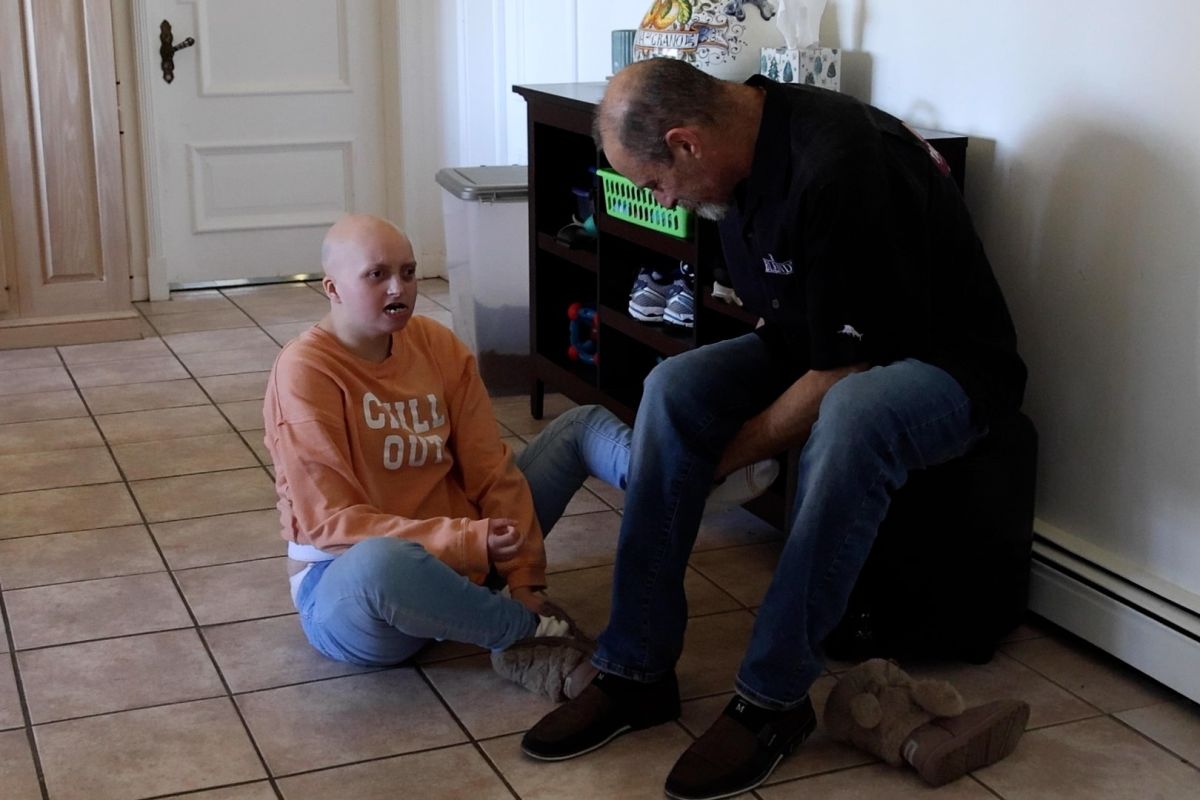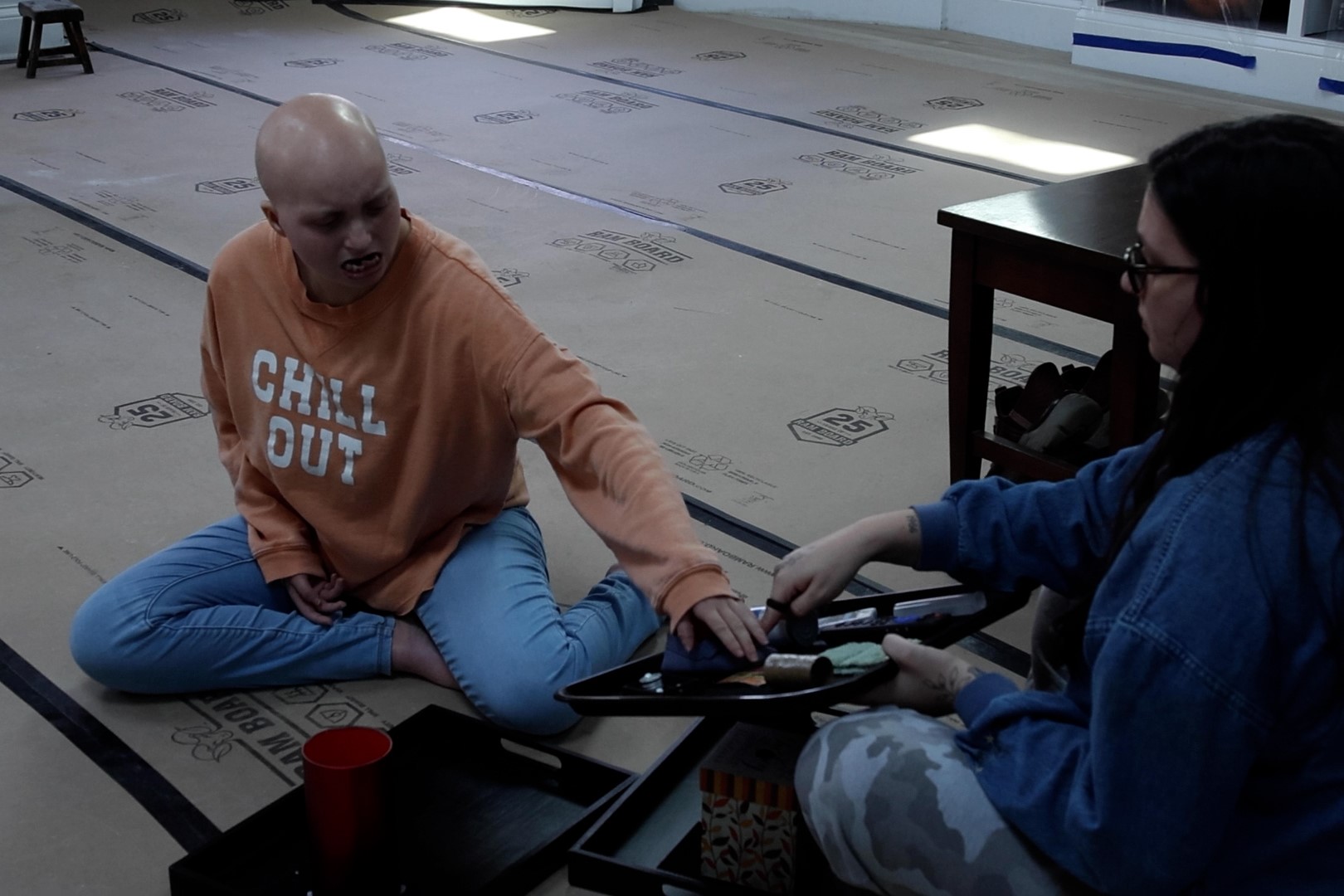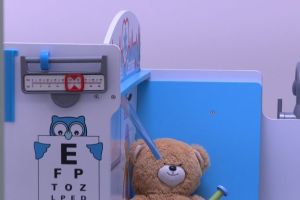
Rob Wilson helps his daughter Olivia put her shoes on. (Alaina Davis)
Indiana’s plan to limit Medicaid-funded behavioral therapy services is worrying for families who fear their kids’ progress will be hindered without consistent support. The plan, if approved by the Centers for Medicare and Medicaid services, will go into effect April 1.
In February, Governor Mike Braun signed an executive order that aims to contain rising Medicaid costs for Applied Behavioral Analysis therapy while also still providing care for people who use it. The press release says that from 2017 to 2019, Indiana Medicaid payments for ABA rose from $14.4 million to $120 million. By 2026, approximately $645 million is expected to be spent on therapy for 8,000 children in the state. The U.S. Office of the Inspector General examined payments from 2019 and 2020.
“The audit found Indiana made at least $56.5 million in improper Medicaid payments for ABA, largely due to problems with credentialing for providers and a lack of evaluations, referrals, and documentation,” the executive order said.
Based on feedback from a working group, the Indiana Family and Social Services Administration adjusted its treatment plan for those seeking ABA therapy. Established are limits on the number of hours an individual can access Medicaid-covered ABA services. Individuals can access ABA services for a maximum of three years starting April 1 regardless of how many hours they have already received, but could still qualify for additional limited hours based on specific need.
Rob Wilson’s daughter, Olivia, has been using ABA services for 12 years. She attended public schools for a few years and did in-person ABA therapy at a facility. Since the pandemic, she has been doing 40 hours a week of therapy from home.

Section 405 IAC 5-22-12 of Indiana’s Administrative Code states that ABA services through Medicaid are available for families from the time of diagnosis through the age of 20. Since Olivia is 22, Wilson has had to push for Olivia to continue receiving 40 hours of Medicaid-funded therapy.
Read more: Gov. Mike Braun creates work group to tackle increased ABA therapy Medicaid costs
Wilson said at-home therapy has been most effective, and has helped Olivia learn how to perform tasks around the house and go out in public to restaurants and her siblings’ sporting events.
“For a while…you couldn't go to a restaurant with her, you couldn't go to an event or something like that, because it was just too difficult,” he said. “ It was kind of sad, because as a family, we would have to do different things. And either some of us would go, some would stay home. But now we can do things together.”
Olivia is nonverbal and has a chromosomal disorder that makes it harder for her to retain information. Wilson said ABA therapy has helped improve communication with her.
“It's frustrating if she can't tell us what she wants,” he said. “It's still difficult, but it's one million percent better with having one-on-one therapy, and her learning to tell us what she wants, what she needs.”

Every six months, Wilson said a court reevaluates Olivia’s condition. He submitted a 104-page report outlining Olivia’s progress on specific goals, how the ABA therapy hours were spent, etc. At the end of last year, based on this report, a court decided to take away five hours of the 40 Medicaid-covered ABA therapy services. Wilson now pays for those five hours out of pocket, amounting to between $500 and $600 a month.
“Five hours a week for her could be the difference of her maybe mastering something,” he said. “…They [politicians] sit and they look at their graphs and scales, ‘well, there’s such a small percentage that that's going to do anything.’”
Wilson said he thinks the money is worth the chance it will help.
The potential for Olivia to make more progress is at stake if the state’s plan to limit services is approved, Wilson said. The routine the therapy has given Olivia has helped her retain information better. Losing that routine will make it hard for her to sustain that progress.
Wilson said he will continue to fight to keep ABA services for Olivia, even if that means paying for all 40 hours out of pocket. That could potentially cost up to $100,000 a year, and Wilson isn’t sure how he could afford that on a Realtor salary.
Sara Shrivastav, owner of Teach and Play ABA in Bloomington, said she is also concerned about kids’ progress if the three-year cap is implemented. Shrivastav organizes a school-styled day for her 17 clients. They go on field trips to the mall and library to practice socializing in public and practice restaurant and barbershop skills at the facility. She said she doesn’t think there is enough evidence to prove that three years of this kind of ABA therapy is enough when autism affects individuals differently at various stages of their lives.

“When kids are really little, learning how to communicate, they might need ABA for two, three years, and then they're ready to go to school,” she said. “The social scene changes when they reach 10,12, and again when they’re teens. And then maybe once they turn 17,18, now they're looking at job placement or college, and now they need support again, and it's something that keeps happening throughout their life,” she said. “So to impose a three-year limit is kind of unrealistic. It's not something like an antibiotic that they can just take and get rid of.”
Read more: FSSA adjusts proposed changes to ABA therapy Medicaid coverage, introduces coverage tiers
Shrivastav said she could offer speech and occupational therapy to those who have run out of funded ABA therapy service hours, but it would be limited to once a week. An extended stay is also possible if the state provides funding, but the service might not be as effective.
“We would have a respite staff, and they could still work on continuation of skills, but it would not be one-on-one. It would be probably like one to five or something like that,” she said. “So I guess that would be the drawback. I think ABA is successful because it's one staff, one client.”

The plan poses other challenges for Shrivastav. Every staff member of hers is already a registered behavior technician, but Medicaid has now imposed additional training requirements to become officially credentialed to work in ABA. Taking longer to train and take on staff could mean that there could be a waitlist of kids waiting to receive services.
With these additional requirements, Shrivastav also foresees fewer people entering the profession. To prepare for potentially fewer staff members, she has downsized from two facilities to one.
Kristie Brown Lofland, president of the executive board of the Autism Society of Indiana, said she can understand from a budget perspective why the state would want to put more of a limit on hours. Since 2001, Indiana Code 27-8-14.2 has mandated that certain insurances provide coverage for individuals with autism.
“What we saw was that every child, every center, would recommend that that child receive 40 hours. And I think insurance companies took a look at that to say, ‘Why? Why does every child get the same treatment? Why is always 40 hours when that may or may not be necessary.?’” she said. “And so I think that might be one reason why we see this mandate, because they wanted to make sure that what they were providing was what the child needed.”
While she doesn’t think limiting access to therapy is a good idea, Lofland said there’s room for potential negotiation depending on individual needs. Every year, the Society participates in a legislation day, where she and other members meet with legislators to talk about what they would like to see change. She said she has had discussions with her colleagues about potentially speaking with legislators about the state’s plan, but thinks families, not professionals, would make a bigger impact on them.
“Typically, the governor, or whoever our legislators are, they're going to listen to parents first before they will listen to professionals,” she said. “It has to be the constituents, the voters.”











